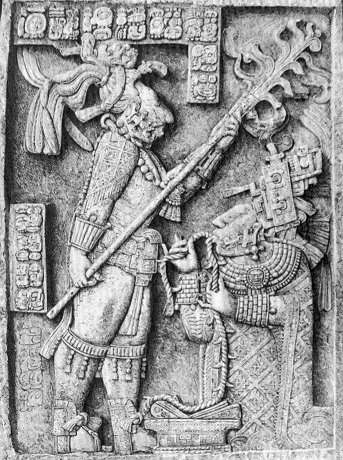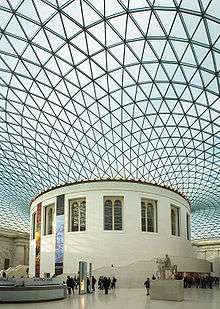Yaxchilan Lintel 24
|
The lintel as displayed in the British Museum | |
| Material | Limestone |
|---|---|
| Created | Estimated to be 709 CE |
| Present location | British Museum, London, England |
Lintel 24 is the designation given by modern archaeologists to an ancient Maya limestone carving from Yaxchilan, in modern Chiapas, Mexico. The lintel dates to about 725 CE, placing it within the Maya Late Classic period. The text of Maya hieroglyphics indicates that the scene depicted is a bloodletting ritual that took place on 5 Eb 15 Mac, 709 CE. The ruler, Shield Jaguar, holds a torch while his consort, Lady Xoc, pulls a rope studded with what are now believed to be obsidian shards through her tongue in order to conjure a vision serpent.
Discovery and removal
Lintel 24 was found in its original context alongside Lintels 25 and 26 in Structure 23 of Yaxchilan. Alfred Maudslay had the lintel cut from the ceiling of a side entrance in 1882 and shipped to Great Britain where it remains today in the British Museum of London. Lintel 25 made the journey in 1883. Lintel 26 was discovered in 1897 by Teobert Maler. It was removed to the Museo Nacional de Antropología e Historia in 1964. Structure 33 has since collapsed.
Inscriptions
“The text consists of two sentences, one relating to Shield Jaguar, the other to his wife. The first three glyphs record the date and the event, “he is letting blood,” with additional glyphs apparently specifying the particular ritual context. Shield Jaguar’s name begins at E2b, with a title telling us he was a “4-Katun ahpo”--- that he had lived into his fourth katun, at the time of the event. His personal name consists of a shield sitting atop a jaguar head. The name phrase concludes by naming him “the captor of Ah-Ahaual” and “a blood lord of Yaxchilan.” The actions of the woman are recorded in the smaller frame behind Shield Jaguar… The last three glyphs record her name phrase.” [1]
Style

The lintel is done in high relief style with the background deeply recessed. All three were apparently commissioned by Lady Xoc for the doorways of Structure 23. The lintels show the elaborate costumes of the king and queen with remarkable detail and with an uncharacteristic lack of abstraction. These lintels are considered by some to be the pinnacle of Mayan Art.[2] We are able to study the detail of Mayan weaving as depicted in these carvings, and see the pearls woven into the fabric. Subtle differences in the three lintels suggest that the compositions were completed by two or three different artists. Each of the works is signed, indicating that the production of such works was regarded as a highly specialized skill rather than a trade.
The King
Shield Jaguar was a central figure in directing the course of Yaxchilan. Shield Jaguar ascended to power in AD 681 and died in AD 742. There are numerous documented references to him on artifacts at the end of Stage V at Yaxchilan. In Lintel 24, he is depicted holding a torch above his first wife, Lady Xoc. The king is wearing his hair back with quetzal feathers indicating that he will also let blood in this ceremony. Attached to his head band is what appears to be a representation of the Jester Mask. The jester mask is considered analogous to the glyph for kingship, ajaw, and is named so for the vegetation often depicted coming from the crown of it. Since the rest of the costume is depicted without much abstraction, it is suggested that Maya kings may have literally attached a shrunken head to their head band as a representation of power. He is shown wearing a pectoral with a representation of the sun god depicted. It is strung from a jade bead necklace that is counterbalanced by a long strand of jade beads and what are probably carved shells going down his back. The artist was careful to show such minute details as the strings that are tied to hold on the wrist cuffs worn by both royals, and the pattern woven on Shield Jaguar’s beautiful cape.
The Queen
.jpg)
Lady Xoc is one of the most prominent and probably politically powerful women in the Maya civilization. Lady Xoc is shown here performing an important royal rite of blood letting. By pulling the rope studded with obsidian shards through her tongue, she causes blood to drip onto paper strips held in a woven basket to be burned as depicted on Lintel 25. Blood scrolls can be seen on her face. The queen also wears an elaborate headdress. There are flower tassels on the main part of the head band and a mosaic depiction of Tlaloc sprouting quetzal feathers. Her elaborately carved huipil is trimmed with fringe and pearls. Her necklace also appears to have a pectoral depiction of the sun god. It is probably made of shell or jade plaques, as are her wrist cuffs.
Associated tombs
Recent excavations have unearthed what is thought to be the tombs of Shield Jaguar and Lady Xoc within Structure 23. Discovered in association with the female burial attributed to Lady Xoc were 146 prismatic obsidian blades, each with two lateral notches on the edges. These were located in what is known as Element 21 in Room 1 of Structure 23 at Yaxchilan. Due to the association with Lady Xoc’s burial in Room 2, these have been interpreted as being depicted on Lintel 24. The original interpretation of the studded rope was that there were thorns attached, but this new evidence in context has caused the interpretation to shift. We now know that it was a rope studded with obsidian blades used in the ritual, and may have the very physical shards depicted themselves. Lady Xoc’s burial is known as Tomb 3. Shield Jaguar’s remains lay not far, in Room 3. This is referred to as Tomb 2. Elaborate grave goods were found in association with both burials.
See also
Notes
- ↑ Based on translation in Schele, Linda, and Mary E. Miller. The Blood of Kings: Dynasty and Ritual in Maya Art. Fort Worth: Kimbell Art Museum, 1986, p. 187.
- ↑ Miller, p. 18, cites Sylvanus G. Morley, who in his Ancient Maya (1946) considered this to be "the most beautiful example of sculptured stone door lintel."
References
- Miller, Mary Ellen (1999). Maya Art and Architecture. London and New York: Thames & Hudson. ISBN 0-500-20327-X. OCLC 41659173.
- Miller, Mary; Simon Martin (2004). Courtly Art of the Ancient Maya. London: Thames & Hudson. ISBN 0-500-05129-1. OCLC 54799516.
- Schele, Linda; Mary Ellen Miller (1992) [1986]. Blood of Kings: Dynasty and Ritual in Maya Art. Justin Kerr (photographer) (2nd paperback ed., reprint with corrections ed.). New York: George Braziller. ISBN 0-8076-1278-2. OCLC 41441466.
- Tate, Carolyn E. (1992). Yaxchilan: The Design of a Maya Ceremonial City. Austin: University of Texas Press. ISBN 0-292-77041-3. OCLC 23464300.

